Most clubs hold one or more internal tournaments per season, so why not show event tables generated for you in your club page? This is easy to do if game results are already being entered into this site during the season for grading, so you just need to define which results are to be included into each table. All club key-holders and selected player keys are able to define the table(s) your club requires, by providing a description and a few parameters. Table content will then appear and automatically be updated as relevant game results continue to be reported. You can define/change a table definition at any time, though defining this before the start of the competition allows players to follow progress from the start and to be reminded of rules throughout the event. Start by selecting a suitable table from your admin page and complete it’s definition. Some examples are shown below.
Cross Tables
Suitable for multi-round Swiss or round-robin competitions. 
Add a cross-table and define it’s properties by entering a table name, general comments and confirm if the event is to be rated or not. Then add any other parameters such as a minimum number of qualifying games, scoring system, start/end dates and preferred default view (‘players x rounds’ is best suited view where there are more players than intended rounds, ‘players x players’ may best suit fewer or no defined rounds – but viewers can toggle between these views anyway). You can define any number of cross-tables.
The game points to be summed up in each cross-table table can be tailored to suit your purpose. The default scoring is standard (1-½-0), though to minimise the likelihood of ties, you may wish to choose from Bilbao (3-1-0) or an entirely bespoke system by supplying your own values for win/draw/loss as Black/White (you can edit it later if end-results require a single tie-break winner(s) to be marked, according to your criteria).
Example admin screen to create a cross-table:-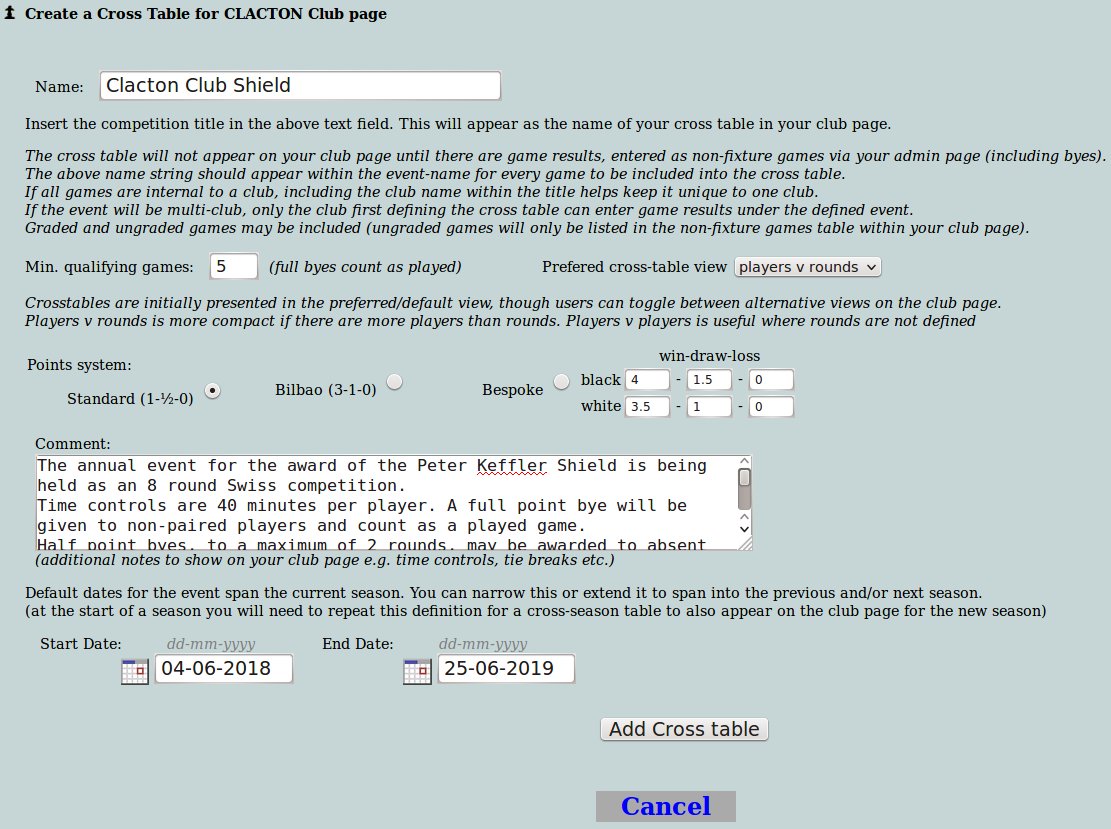
A table will be displayed in your club page when there are results to be included – these will be internal game results where the selected ‘game event name’ is that of your cross table.
If a minimum number of qualifying games was specified, the table data of players with sufficient games to qualify will appear in bold. Leaders will be highlighted with a green background in the selected ordering. Non-qualifying data is in italic/greyed. The example screen-shot below is taken from Clacton 2015/16.
Viewers can display the table ordered by points (default), performance, or by performance-minus-grade (by clicking on the appropriate column heading):-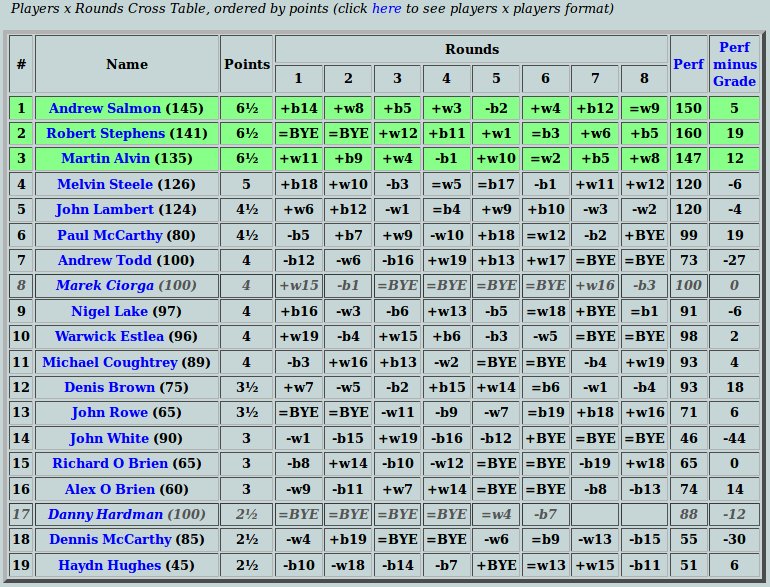
Cells may have more than one game result (for example where Black and White are played against the same opponent in the same ’round’) and are shown comma-separated within cells, so you don’t have to regard each encounter as a separate round – and if you don’t want to name any rounds as such, the ‘player x rounds’ format will just show each players results under a single unnamed ’round’.
The initial format for the table will be according to the preferred view stated in your table definition, though anyone viewing the table can flip the display they see between views by clicking the link above the table. The mid-season ‘player x player’ example screen-shot below was taken from Dunmow 2018/19 results.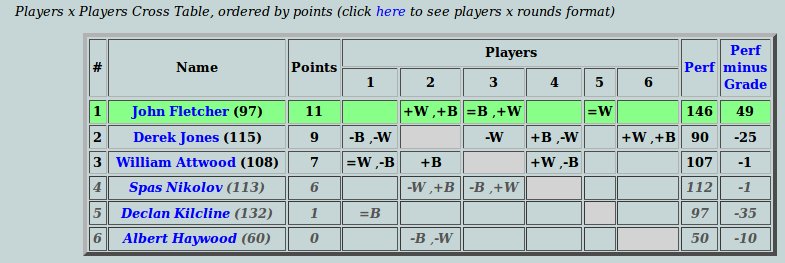
You can create a link for use in emails or web page links with a URL of the form http://necl.org.uk/summarybyclub.php?year=2015&club=CLACTON#crosstable
To ensure the specific view where columns are to be players, the form will be
http://necl.org.uk/summarybyclub.php?club=DUNMOW&year=2018&cols=players#xtable
(edit the URL to suit your club/season, other examples here, here, here)
Knockout Tables
Knockout tables show pairings and results with winners of each round highlighted
(who then go into the next round). First define a knockout table from your admin page.

Enter a table name and confirm if the event is to be rated or not.
Then add any explanatory comments and dates for the period of the event.
You can define any number of knockout tables.

When you later enter your game results, select the knockout event name for those games to be included in the table which will be displayed in your club page. You can define any number of KO events, using different names, such as a ‘Plate’ for players knocked out in a first round. Example output shown below for 2018/19 Brentwood Club Championship.
A Knockout Summary Tree of your results will also be generated and appear under your table.
More on Cross Tables and Knockouts
Rounds: If an event has rounds (not applicable to ladders), the round entered must be consistent for all games of the same round. e.g. if round 2 of a knockout is a quarter-final, the program will not know this, so if some games are entered with a round of ‘2’ and others as ‘QF’ these will show as two separate rounds until you edit one or the other to show as the same name or number. If ALL rounds are entered as numeric, the displayed ordering in tables will be numeric, otherwise ordering will be by date of last game in each defined round.
Byes: To award a bye in a Cross Table or Knockout Table, enter a result that selects the player as white (though no colour will be allocated) and then select opponent ‘BYE’ as black, choosing a score that gives the player a half or full point as appropriate.
Ladder Tables
These are useful to show participation in club games/challenges taking place over a defined period within a season (possibly over the whole season), not necessarily structured into rounds and often with few constraints. The 2012/2013 season saw incentives that influenced non-match games in some clubs away from being ‘mostly casual’. Grading Fee changes meant most players became direct ECF members, entitled to have any number of club games graded at no extra cost. The ‘ladder’ software was developed after the event suggested at the 2012 Clacton AGM by Martin Alvin, to be based on all qualifying internal games throughout the season. A trophy was later organised to provide something extra to play for. The ladder was adapted from one of Martin’s previous clubs, who in turn adapted it from elsewhere so we do not know who should take original credit for this. Everyone starts on the same initial (e.g. 50) points and then acquire or loose points based on a scoring system which (as with ELO/ECF grades) adjusts the points for wins and losses based on the current points difference between players. You can state a minimum number of games to qualify for a placing but there is no limit on how few or how many games each person plays. This makes it very easy to run with typical ad hoc club attendances and no pairing requirements to organise!
Initially done on spreadsheet, tracking the scoring of players as game results were reported was susceptible to errors which had a ripple effect on later games. Although Andrew and John kept separate copies and compared notes from time to time, adding in a previously omitted game still involved significant rework/re-sorting. Also, results were not very visible unless the spreadsheet was uploaded. As game results were already being entered on-line I proposed that the web-server do the arithmetic instead and programmed this as a generic facility available to all league clubs who run similar ladders. Providing a trace facility also gave visibility to each stage of the calculation for the benefit of any players wishing to check details. The suggested rules are published here. You can view Clacton club pages for any season after 2012/13 to see examples as it has remained a popular club favourite. Player names are ‘greyed’ until playing the minimum games for a place and any green row(s) in the table indicate the highest scoring qualifying player(s).
You can define any number of ladders. When you later enter your game results, select the named ladder event for those games to be included in the appropriate table. 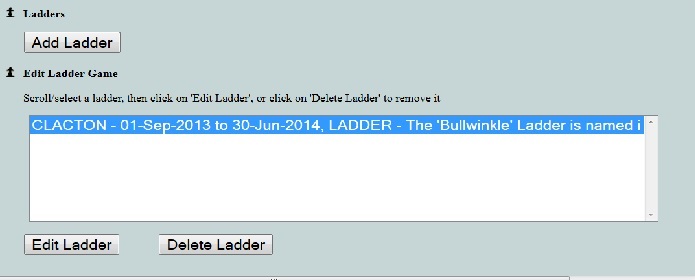
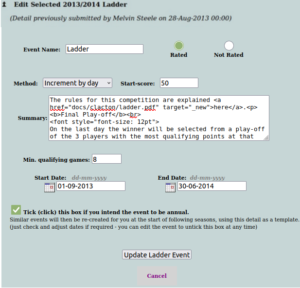
You can crate a link for email or web pages using a URL of the form
http://necl.org.uk/summarybyclub.php?year=2016&club=Clacton#ladder
(edit to your club/season)
If unsure about which calculation method to choose, “increment by day” is suggested.
“increment by game“ – adjusts player scores after each game, so games played within the same day need to be entered in strict played order – or different final scores may result!
“increment by day“ – adjusts player scores once for all gains/losses of each day, so results can be entered at any time and in any order to produce consistent final scores.
( e.g. use separate windows to scroll down an alongside comparison between the Clacton trace result for 2012/13 season which used the “increment by game” method, and the would-be trace result if “increment by day” had been used. Note the small end-of-day differences that grow to produce a different overall end-result/winner – this is why Clacton used increment by day thereafter!)
When entering game results, click the ladder event name in the pick list on the data entry page to link these to your ladder event.

Updated 2022: add refs to event rating, remove refs to tags (legacy)
2016: Cross table descriptions added.
2018: add bespoke scoring, multi-game cells, ‘player x player’ cross-table format.
2019: added section on KO tables.

